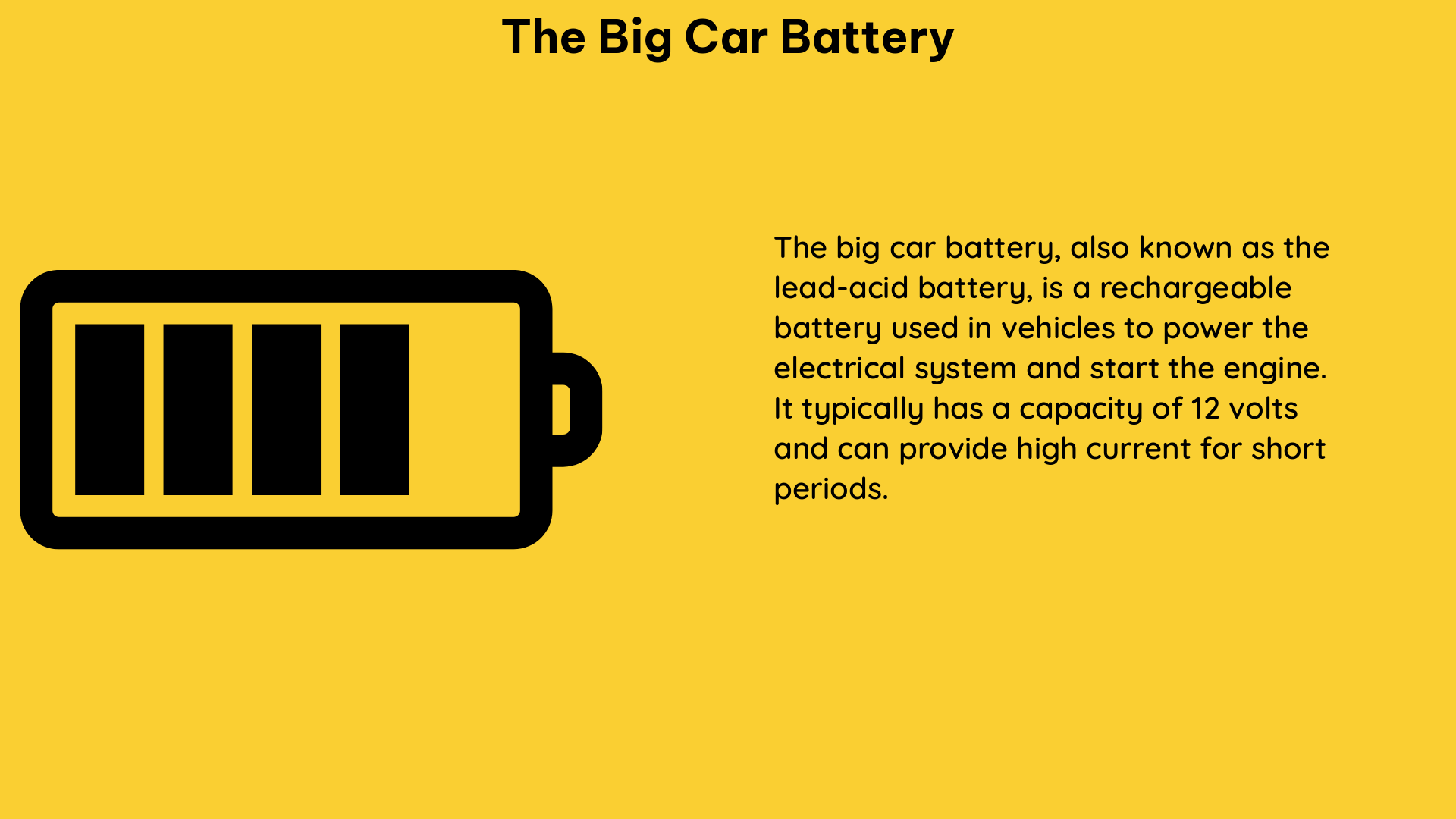The big car battery, also known as a high-voltage traction battery, is a critical component of electric vehicles (EVs) that stores the energy required to power the electric motor. These batteries typically have a voltage range of 200 to 400 volts and a capacity of 20 to 100 kilowatt-hours (kWh), making them a powerful and essential part of EV technology.
Understanding the Battery Pack
The big car battery pack is usually composed of multiple lithium-ion cells connected in series and parallel to achieve the desired voltage and capacity. For example, a 400-volt battery pack with a capacity of 60 kWh may consist of 200 cells, each with a voltage of 2 volts and a capacity of 30 ampere-hours (Ah).
Battery Cell Specifications
- Voltage: 2 to 4 volts per cell
- Capacity: 20 to 60 Ah per cell
- Energy Density: 150 to 250 Wh/kg
- Power Density: 300 to 1000 W/kg
Battery Pack Specifications
- Voltage: 200 to 400 volts
- Capacity: 20 to 100 kWh
- Energy Density: 100 to 200 Wh/kg
- Power Density: 200 to 500 W/kg
Physical Characteristics

The physical size and weight of a big car battery can vary significantly, but they are generally large and heavy due to the number of cells required to achieve the desired voltage and capacity. A typical battery pack can weigh between 300 to 600 kilograms (660 to 1320 pounds) and have dimensions of approximately 1 to 1.5 meters (3.3 to 4.9 feet) long, 0.5 to 0.7 meters (1.6 to 2.3 feet) wide, and 0.3 to 0.5 meters (1 to 1.6 feet) high.
| Dimension | Range |
|---|---|
| Length | 1 to 1.5 meters |
| Width | 0.5 to 0.7 meters |
| Height | 0.3 to 0.5 meters |
| Weight | 300 to 600 kilograms |
Battery Management System (BMS)
The big car battery is equipped with a Battery Management System (BMS) that monitors and controls various aspects of the battery pack, including:
- State of Charge (SOC): Measures the available charge in the battery.
- State of Health (SOH): Indicates the overall condition and degradation of the battery.
- Voltage and Current Monitoring: Ensures the battery cells are operating within safe limits.
- Thermal Management: Regulates the temperature of the battery pack to optimize performance and safety.
- Cell Balancing: Maintains an even charge distribution across all cells in the pack.
The BMS plays a crucial role in maintaining the battery’s longevity and ensuring the vehicle’s safety and performance.
Environmental Impact
The production of a big car battery can have a significant environmental impact, with estimates of 15 to 20 metric tons of CO2 equivalent emissions per battery, depending on the location and energy mix of the manufacturing facility. However, despite this impact, EVs still offer a more sustainable transportation solution than traditional gasoline-powered cars, especially when charged with renewable energy sources.
Maintenance and Monitoring
Proper maintenance and monitoring of the big car battery are essential to ensure its longevity and optimal performance. Key maintenance tasks include:
- Keeping the battery pack clean and dry to prevent corrosion and damage.
- Regularly checking the battery’s SOC and SOH to identify any issues early on.
- Ensuring the BMS is functioning correctly and updating the firmware as needed.
- Avoiding extreme temperatures and overcharging, which can accelerate battery degradation.
- Considering battery replacement or reconditioning when the SOH drops below a certain threshold.
By following these maintenance practices, EV owners can maximize the lifespan and efficiency of their big car battery.
Conclusion
The big car battery is a complex and critical component of electric vehicles, with a range of technical specifications and characteristics that impact the vehicle’s performance, range, and charging time. Understanding the details of these batteries, from their cell-level specifications to their physical dimensions and environmental impact, is essential for EV owners, technicians, and enthusiasts alike. By staying informed and following proper maintenance practices, EV owners can ensure their big car battery continues to power their vehicles reliably and efficiently.
References:
– How much CO2 is emitted by manufacturing batteries? | MIT Climate … (n.d.). Retrieved May 26, 2024, from https://climate.mit.edu/ask-mit/how-much-co2-emitted-manufacturing-batteries
– Electric vehicles are powered by lithium-ion batteries (LIB), a rechargeable battery that’s still not fully understood or perfected. (n.d.). Retrieved May 26, 2024, from https://energsoft.com/data-science/f/what-is-inside-the-battery-big-data?blogcategory=Automotive
– Wang, D., Coignard, J., Zeng, T., Zhang, C., & Saxena, S. (2016). Quantifying electric vehicle battery degradation from driving vs. vehicle-to-grid services. Journal of Power Sources, 331, 32-41. doi:10.1016/j.jpowsour.2016.06.045
– Electric Vehicle Batteries: Status and Perspectives of Data-Driven … (2022). Retrieved May 26, 2024, from https://www.mdpi.com/2313-0105/8/10/142

The lambdageeks.com Core SME Team is a group of experienced subject matter experts from diverse scientific and technical fields including Physics, Chemistry, Technology,Electronics & Electrical Engineering, Automotive, Mechanical Engineering. Our team collaborates to create high-quality, well-researched articles on a wide range of science and technology topics for the lambdageeks.com website.
All Our Senior SME are having more than 7 Years of experience in the respective fields . They are either Working Industry Professionals or assocaited With different Universities. Refer Our Authors Page to get to know About our Core SMEs.